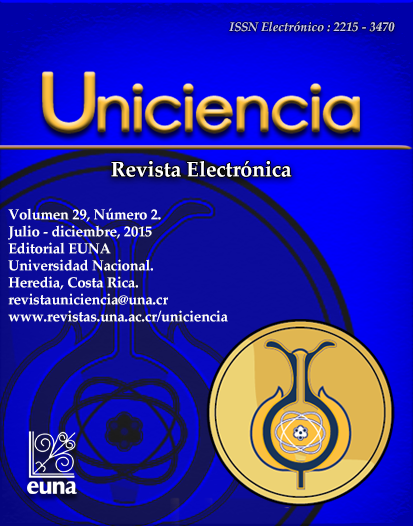Implementation of SQL Symbolic Extensions on Object-Relational Database
DOI:
https://doi.org/10.15359/ru.29-2.2Keywords:
Database, extension, relational-object, SQL, symbolic-objectAbstract
This article proposes extend the SQL language with new data types and operators for create and manipulate symbolic objects directly in the database. The functionality of the proposed extension is validated by performing transformations of classical symbolic objects to relational data bases of large data. For users not familiar with the SQL language, a final user interface is built to facilitate and guide the process of symbolic transformation.
References
Billard, L. (2006). Symbolic Data Analysis: Conceptual Statistics And Data Mining. New York: Wiley. DOI http://dx.doi.org/10.1002/9780470090183
Bock, H-H., & Diday, E. (2000). Analysis of Symbolic Data. Exploratory methods for extracting statistical information from complex data. Springer Verlag, 425.
Codd, E. (1970). A relational model of data for large shared data banks. Communications of the ACM, 377-387. DOI http://dx.doi.org/10.1145/362384.362685
Diday, E. (2009). The state of the art in symbolic data analysis: overview and future. Obtenido de http://media.wiley.com/product_data/excerpt/36/04700188/0470018836-1.pdf
Moore, R. (1979). Methods and Applications of Interval Analysis. Philadelphia, USA: Society for Industrial and Applied Mathematics (SIAM)
Rodríguez, O. (2000). The Knowledge Mining Suite (KMS). San José, Costa Rica: University of Costa Rica and Predisoft International S.A
The PostgreSQL Global Development Group. (2012). PostgreSQL Developer's Guide. Obtenido de http://www.postgresql.org
Downloads
Published
Issue
Section
License
Authors who publish with this journal agree to the following terms:
1. Authors guarantee the journal the right to be the first publication of the work as licensed under a Creative Commons Attribution License that allows others to share the work with an acknowledgment of the work's authorship and initial publication in this journal.
2. Authors can set separate additional agreements for non-exclusive distribution of the version of the work published in the journal (eg, place it in an institutional repository or publish it in a book), with an acknowledgment of its initial publication in this journal.
3. The authors have declared to hold all permissions to use the resources they provided in the paper (images, tables, among others) and assume full responsibility for damages to third parties.
4. The opinions expressed in the paper are the exclusive responsibility of the authors and do not necessarily represent the opinion of the editors or the Universidad Nacional.
Uniciencia Journal and all its productions are under Creative Commons Atribución-NoComercial-SinDerivadas 4.0 Unported.
There is neither fee for access nor Article Processing Charge (APC)






